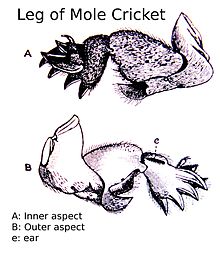Fossorial

A fossorial animal (from
) are fossorial.Prehistoric evidence
The physical adaptation of fossoriality is widely accepted as being widespread among many
Physical adaptations in vertebrates

There are six major external modifications, as described by H. W. Shimer in 1903,[5] that are shared in all mammalian burrowing species:
- Fusiform, a spindle-shaped body tapering at both ends, adapted for the dense subsurface environment.
- Lesser developed or missing eyesight, considering subsurface darkness.
- Small or missing external ears, to reduce naturally occurring friction during burrowing.
- Short and stout limbs, since swiftness or speed of movement is less important than the strength to dig.
- Broad and stout forelimbs (manus), including long claws, designed to loosen the burrowing material for the hind feet to disperse in the back. This trait is disputed by Jorge Cubo, who states that the skull is the main tool during excavation, but that the most active parts are the forelimbs for digging and that the hind-limbs are used for stability.[6]
- Short or missing tail, which has little to no locomotor activity or burrowing use to most fossorial mammals.[5]
Other important physical features include a subsurface adjusted skeleton: a triangularly shaped skull, a
For animals that burrow by compressing soil, the work required increases exponentially with body diameter. In amphisbaenians, an ancient group of burrowing lizard-like squamates, specializations include the pennation of the longissimus dorsi, the main muscle associated with burrowing, to increase muscle cross-sectional area. Constrained to small body diameters by the soil, amphisbaenians can increase muscle mass by increasing body length, not body diameter.[9] In most amphisbaenians, limbs were lost as part of fossorial lifestyle. However the mole lizard Bipes, unlike other amphisbaenians, retains robust digging forelimbs[10] comparable to those of moles and mole crickets.
Physiological modifications

Many fossorial and sub-fossorial mammals that live in temperate zones with partially frozen grounds tend to hibernate due to the seasonal lack of soft, succulent herbage and other sources of nutrition.[5]
W. H. Shimer concluded that, in general, species that adopted fossorial lifestyles likely did so because they failed, aboveground, to find food and protection from predators.[5] Additionally, some, such as E. Nevo, propose that fossorial lifestyles could have occurred because aboveground climates were harsh.[11] Shifts towards an underground lifestyle also entail changes in metabolism and energetics, often in a weight-dependent manner. Sub-fossorial species weighing more than 80 grams (2.8 oz) have comparably lower basal rates[specify] than those weighing lower than 60 grams (2.1 oz). The average fossorial animal has a basal rate between 60% and 90%. Further observations conclude that larger burrowing animals, such as hedgehogs or armadillos, have lower thermal conductance than smaller animals, most likely to reduce heat storage in their burrows.[12]
Geological and ecological implications
One important impact on the environment caused by fossorial animals is bioturbation, defined by Marshall Wilkinson as the alteration of fundamental properties of the soil, including surface geomorphic processes.[13] It is measured that small fossorials, such as ants, termites, and earthworms displace a massive amount of soil. The total global rates displaced by these animals are equivalent to the total global rates of tectonic uplift.[13] The presence of burrowing animals also has a direct impact on the soil's composition, structure, and growing vegetation. The impact these animals have can range from feeding, harvesting, caching and soil disturbances, but can differ considering the large diversity of fossorial species – especially herbivorous species. The net effect is usually composed of an alteration of the composition of plant species and increased plant diversity, which can cause issues with standing crops, as the homogeneity of the crops is affected.[14] Burrowing also impacts the nitrogen cycle in the affected soil. Mounds and bare soils that contain burrowing animals have considerably higher amounts of NH+
4 and NO−
3 as well as greater nitrification potential and microbial NO−
3 consumption than in vegetated soils. The primary mechanism for this occurrence is caused by the removal of the covering grassland.[15]
Burrowing snakes may be more vulnerable to changing environments than non-burrowing snakes, although this may not be the case for other fossorial groups such as lizards. This may form an evolutionary dead end for snakes.[16]
See also
References
- ^ PMID 12965004.
- S2CID 21755491.
- S2CID 37351505.
- PMID 26702436.
- ^ a b c d e Shimer H.W., 1903, Adaptations to aquatic. Arboreal, fossorial, and cursorial habits in mammals.III. Fossorial Adaptations, The American Naturalist, Vol.XXXVII, No. 444 – December 1903
- ^ Cubo, J, 2005, A heterochronic interpretation of the origin of digging adaptions in the northern water vole, Arvicola terrestris (Rodentia: Arvicolidae), Biological Journal of Linnean Society, Volume 87, pp. 381–391
- ^ Narins, P. M, 1997, Use of seismic signals by fossorial south African mammals: a neurological goldmine, Brain research bulletin, Vol. 44, Issue 5, pp. 641–646
- ^ Mason, M. J., 2001, Middle ear structures in fossorial mammals: a comparison with non-fossorial species, Journal of Zoology, Vol. 255, Issue 4, pp. 467–486
- PMID 15184515.
- PMID 30630409.
- ^ Nevo, E. 2007. Mosaic evolution of subterranean mammals: Tinkering, regression, progression, and global convergence. Subterranean Rodents: News from Underground: 375–388.
- ^ McNab, B, 1979, The Influence of body size on the Energetics and Distribution of Fossorial and Burrowing Mammals, Ecology, Volume 60, pp. 1010–1021
- ^ a b Wilkinson, M.T, Richards, P.J., Humphreys, G.S., 2009, Breaking ground: Pedological, geological, and ecological implications of soil bioturbation, Earth-Science Reviewss, Vol. 97, Issues 1-4, pp. 257–272
- ^ Huntly, N, Reichman, O.J., 1994, Effects of Subterranean Mammalian Herbivores on Vegetation, Journal of Mammalogy, Volume 75, pp. 852–859
- ^ Canals, H, 2003, How Disturbance by Fossorial Mammals Alters N Cycling in a California Annual Grassland. Ecology, Volume 84, pp. 875–881
- S2CID 4619858.
- "Fossorial - Definition of Fossorial". Amateur Entomologists' Society. Retrieved 1 September 2012.
- "Fossorial Legs". University of Sydney. Retrieved 1 September 2012.
